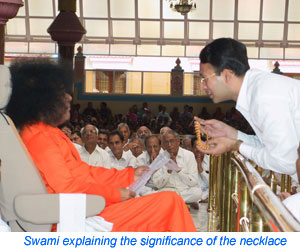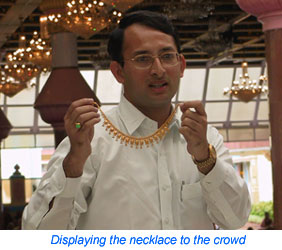 |
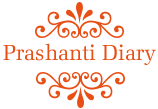 |
 |
| Volume
3 - Issue 8 AUG 2005 |
Swami returned to Parthi from Brindavan on June 18, 2005 , in the afternoon. The Lord Who is the Master of Time, did not waste any time in giving an invigorating Divine Discourse on Seva activities to be performed in the drought affected villages of the region the very next day. JUNE 19, 2005 : A DIVINE DISCOURSE In Sai Kulwant Hall, in the afternoon of June 19, 2005 , Swami said, "In Bharat, of late, we have been coming across a number of problems. This is quite natural. But it is our responsibility to enquire and investigate. In the last couple of months there have been a number of problems and obstacles that have caused a loss of happiness and bliss to people. More than our studies, our actions are important. We must necessarily make an effort to improve the existing situation. There is no water to drink. Earlier we have taken every care to supply water for drinking. Now the problem is very severe and has spread all over Anantapur District. We are not born merely to earn a living, we do not study merely to fill our stomachs; all that we have learnt must be put into practice to serve our fellowmen and community. We have to realise the plight of the people in every district. We must first convince ourselves and then share with others the Supreme Will and Mystery of God. Food should be served when one is hungry. One must determine to undertake the task though it may be strenuous. Service cannot be done by wealth alone. We need men of character. Foreigners too will be participating in this mega service programme. We have to supply drinking water to every village. The problem does not end there. We must supply food too. All aged 10 years and above must participate in this programme. We must be determined to accomplish the project in its entirety. Temperament and attitude is very important". (Editors note: Currently planning for the project is almost complete and the project will commence as soon as Swami gives His blessings)
JUNE 20: A DRAMA BY THE ORPHANAGE BOYS - "LOKA SAMASTHA SUKHINO BHAVANTU" On June 20, on the third anniversary of the Sri Sathya Sai Deena Janodharana Pathakam (Swami's orphanage), the inmates presented a programme to express their thanks to Bhagavan for waking them up from a life of destitution to His benign, soothing lap and giving them a new life altogether. On this day, they presented some of Swami's wisdom imparted through precepts and parables by means of a dance drama, dedicated with reverence at His Lotus Feet. They used Potana's (a great poet from Andhra Pradesh) prayer poem, Evvani che Janinchu, to set the tone of total surrender in the presentation. Reverberating to the undercurrent of a drum beat (to warn of the futility of running after riches), the drama was an eclectic mixture of songs, dances, Burra Katha (a popular Telugu rural folk art of story telling) and short skits. The well rehearsed drama effectively brought out Swami's main teachings on the importance of Satsang (good company), Namasmarana (Continuous recitation of the Lord's name), Morality (Money comes and goes, morality comes and grows) through effective short skits. The last skit of a fisherwoman who pulls out a boy from the sea and brings him to the local doctor who even refuses to see him as he is otherwise occupied in the paper currency chase. The boy (who dies because of the lack of timely help) turns out to be the doctor's own son. Sai's vibhuti however brings the young boy to life and also kindles the flame of service in the now reformed doctor. All the 62 inmates participated in the drama. After the drama, Swami called the children to Him (scene by scene) and profusely blessed them all.
JUNE 21: A FOLK DANCE BY VILLAGERS FROM CHHATTISGARH The Sathya Sai Seva Organization from the district of Durg in the Indian State of Chhattisgarh in India have adopted a few villages in their immediate area for service activities like providing drinking water, conducting medical camps, distributing clothes and blankets to the poor and needy, renovating temples, and conducting group marriages. The people from these villages along with the Seva Dals from the area came on a 'Parthi Yatra' (Pilgrimage to Parthi) to express their grateful homage at Bhagavan's Lotus Feet. As part of their celebration they performed a folk dance from the heart of Chhattisgarh called "Panthi Nritya", before the Lord. It was performed by a tribal group called Satnamis. The various dance postures depict how the dancers worship their guru Sant Ghasidas. Their dance master Sri Dev Das Banjare has received many national and international awards and has performed in 64 countries. Swami was deeply engrossed at this vibrant fast paced dance with a rural flavour that included loud drum beats and cymbals, which lasted for about 30 minutes. After the dance, the leader of the troupe Sri Srinivas, briefed Swami about their service activities. Swami looked through all the photographs and asked him details about all the seva activities for a full 20 minutes. "Chala Santosam" was the divine response at the end - "Very Happy", and it brought broad smiles on the faces of all the Seva Dals. The devotees of Chhattisgarh also had the opportunity to perform the bhajans for Swami that evening.
JUNE 23rd: TALKS BY SRI ANIL GOKAK AND SRI S.V.GIRI AND AN UNEXPECTED DIVINE DISCOURSE Bhagavan was out in this evening at 4.00 p.m. He stopped the Vedam chanting at 4.05 p.m. and commanded Prof. Anil Gokak - the current Vice Chancellor of the Sri Sathya Sai Institute to speak a few words. Prof. Gokak stated his talk by recalling the early part of his father's life (His father Dr. V.K. Gokak was the first vice-chancellor of the Institute). He also went down memory lane and stated that Bhagavan had extended his mother's life by 18 years and his father's life by 5 years. Continuing he related how he came to Swami's fold. Referring to Swami's social projects, he aptly referred to Bhagavan as a 'Vedantic Socialist'. He concluded his talk by drawing an analogy between an Avatar and a pilot who temporarily brings down his plane to the ground to take a few passengers and then return back to the skies! Swami next commanded Sri S.V. Giri, the former Vice-Chancellor to share his thoughts with the audience. Sri S.V. Giri also struck a personal note talking about the heart surgery that he had for the first time in 1989. Over time, though another 4 of the 5 heart passages had been blocked, Bhagavan had said there was no need for any further surgery. And he has been continuing to discharge all his responsibilities - purely on account of Bhagavan's Grace! He then shared how Swami had made sure that his resignation from the post of the CVC (Central Vigilance Commissioner) - Government of India was accepted without any complications. Sri Giri stressed on the three most important facets of this Institute - Service, Society and Faith. He concluded his talk by stressing on the Truth elucidated by our scriptures that all is one. Next to the delight of all Swami gave His Divine Message. Mikes were soon kept in place. Swami asked all the students to come closer and naturally they were most happy, climbing all the way right up the steps. Swami, in His discourse, initially described in elaborate terms the spiritual journey of Prof. Vinayak Gokak - the father of the current Vice-Chancellor and the first Vice-Chancellor of the Sri Sathya Sai Institute of Higher - to Swami. Swami elaborated on how He helped Sri Gokak understand the difference between Atma and Anatma, Sathyam and Nityam and helped him realize the Eternal Truth. Swami also said that when Vyashti (individual) identifies himself with Samashti (community), only then can he realise Parameshti (God). It is very difficult to understand Parameshti which is beyond both Vyashti and Samashti. There will be harmony between Vyashti and Samashti when one develops equanimity. Vyashti i.e. the individual constitutes Samashti, the community and Samashti is the collective form of Vyashti. One who understands this relationship between Vyashti, Samashti and Parameshti (God) can know the truth. We can understand the reality only when we transcend worldliness. Total change cannot come instantly. Gokak understood and held on to this truth fully well and forgot everything else, Swami said.
JULY 4: THE ONLY ELEMENT- A DRAMA BY DEVOTEES FROM REGION X , USA The Sai Spiritual Education Children from the Texas region of USA put up a drama to celebrate the Independence Day of the United States . The North American continent before it was "discovered" was home to the Native Americans who respected Nature and worshipped the 5 elements as life sustaining forces and as the Great Spirits. The play was inspired in part by the history of this culture by drawing on the story of the celebration of Thanksgiving. The early pilgrims who arrived tired, cold and hungry, from across the seas were well received by the natives. They gave them seeds to plant and helped them settle down in their adopted land. Next autumn, when the pilgrims had a bountiful harvest, they decided to offer thanks to the Lord for the bounty and invited the natives to join them in the celebration. This was the first American Thanksgiving, and it is still being celebrated, though the people in the cities and towns have lost touch with Nature and the Elements. In the present day, Thanksgiving in America is an occasion for families and perhaps close friends to get together to celebrate with food and plenty. The story revolves around 2 boys - Shawn (from a good, affluent family that however has lost touch with the hardships faced by the poor) and Sid (whose affluent family serve the poor and needy as service to the Lord Himself). After one Thanksgiving Day feast, Shawn goes with Sid's family as they serve food to the homeless at the downtown shelter and has an intriguing experience. Realizing the bounty of the gift of food provided by Mother Earth, he goes on to serve a thirsty person Water, gives a blanket to a shivering person (Fire), and a fan provides Air to a person wilting in the heat; all this happens in the space (Ether) created by God. This brings home to Shawn the connection between service and the five elements that make up the entire Universe. Above all, the seva experience makes Shawn evolve and realize that the Only Element is LOVE……. JULY 18: ASHADA EKADASHI CELEBRATIONS THE MORNING PROGRAMME: Drama "God Is The Only Friend" By The Bala Vikas Children Of Mumbai. Drawing inspiration from their proximity to the film industry in Mumbai, popularly known as "Bollywood", the kids bring out that man today lives in the delusion that he is the doer. The true reality however is that the doer is someone infinitely more powerful…more effulgent…more grand…God Himself. The story revolves around Amit Kumar, a "hero" (a leading man) in the film industry who is currently riding tall on the crest of the success of his latest movie at the box office. This brings him numerous accolades and of course the fair weather friends and sycophants, who praise him and his abilities to the sky. Though Amit always starts his new ventures with a prayer to the Lord, he however believes he is infallible and that he can do everything. Predictably, the next venture "Dost" (into which he has sunk all his life savings) fails miserably at the box-office in India and he is staring at total ruin. All his friends desert him and he is thus totally alone. This is when God (Who has been in the back-ground all the time) enters his life and shows our hero, that in life God is the only friend. Amit realizes the error of his ways swiftly - that the real doer is God and that man is only a witness. The story ends on a happy note in that Amit's picture does well at the box-office abroad thus saving Amit from ruin. With gorgeous film style sets, fast foot-tapping songs and colourful vibrant dances, it was certainly a different fare than what is normally seen in Sai Kulwant Hall, but one that resonated well with the crowd and drove the point home. The organizers additionally provided a wrist band inscribed with the words "God is the only friend" so one could also literally take the message home. THE EVENING PROGRAMME: Drama "Krishna-Uddhava" By The Bala Vikas Children and Youth Wing Of the Sri Sathya Sai Seva Organizations, Nagpur In the evening there was another rich feast in store, continuing with the same theme of friendship with the Lord, offered by the children of Nagpur - a musical ballet entitled "Krishna-Uddhava'. 'Krishna-Uddhava' depicted the saga of the unique love and friendship that existed between Uddhava and Krishna . Even from childhood, Krishna was Uddhava's dearest friend and his very life-breath. Krishna too reciprocated by the words, 'Na thatha me priystham aathmyonirna shankara Na cha sankarshano na shri naivaatma cha yatha bhavaan' . 'O Uddhava, Siva, Brahma, Balaram, Lakshmi and even my very own Atma are not as dear to me as you are'.
The musical ballet brought out tenderly how right from a very early age, Uddhava yearned from the innermost recesses of his heart to make Krishna his best friend. Sitting, lying, walking, sleeping, talking, eating and playing with Krishna , Uddhava lived as Krishna 's shadow - two bodies with one heart as it were. One day Krishna sends him to visit His parents in Brindavan and also to bring solace to His dear devotees - the Gopikas. Uddhava, who was a Jnani - a man of wisdom, was rather proud of his learning and knowledge so Krishna wanted him to experience the all encompassing bliss that could be derived from the total surrender and love of the Lord. From the simple cowherd maids, the Gopikas, the learned Uddhava witnessed, experienced and learnt Bhakthi or total devotion to the Lord. In the final scene, known in the Bhagavatham as the Uddhava Gita, Krishna helps Uddhava realize his oneness with the Lord. He gifted him His Padukas, or divine sandals, the symbol of the Divine Lotus Feet and the ultimate goal of all devotees. The musical ballet ends poignantly by inspiring all of us to grasp this opportunity and make Sai our dearest friend. JULY 19, 2005 : EASWARAMMA WOMEN'S WELFARE PROJECT (EWWP) INAUGURATION THE MORNING PROGRAMME: Swami Inaugurates The EWWP
On Ladies' Day, 19th November 2004 , Swami inaugurated the Easwaramma Women's Welfare Project. As a follow-up to it, with Swami's infinite Grace and Blessings, the Easwaramma Women's Welfare Trust was established to benefit women at large. It was founded on the teachings of Bhagavan to reach out to the problems of women in a meaningful way, and bring peace and comfort, without any distinction of religion, caste, colour or creed. Under the auspices of the Easwaramma Women's Welfare Project, a Mother and Child health care programme will be offered in villages on a regular basis providing the foundation for a healthy society. The programme is initially operational in the villages in and around Puttaparthi with the scope slowly expanding to include a growing number of villages. The Mother and Child programme will schedule monthly visits to villages and include trained doctors, nurses and volunteers. The groups will be equipped with all the necessary equipment to conduct pre-natal checkups for monitoring the health of the mother and foetus, provide nutritional supplements and education on health care during pregnancy. Additionally, the Easwaramma Self-Help Programme for women seeks to empower women to achieve self reliance and to provide a means of steady livelihood and thereby improve the health and quality of life of women and their families. The programme will train women in making a variety of useful and saleable products using locally available and environmentally friendly raw materials for sustained development. On the morning of the 19th, Swami came to inaugurate the premises of the Easwaramma Women's Welfare Trust. Spending over half an hour, He visited all the rooms in the building and listened with interest to the presentations and blessed all the aspects of the programme including the Mother and Child medical van parked right outside. After taking arathi, Bhagavan left to give darshan to the devotees assembled in Sai Kulwant Hall. THE EVENING PROGRAMME: Concerts By Renowned Women Artists The afternoon served up a delectable feast of music to please everyone's heart by two of the most renowned artists of India . Featured were Vidushi Sumitra Guha singing Hindustani - the classical music of North India and Ms Bombay Jayashri Ramnath singing Carnatic Vocal Music widely prevalent in Southern India .
Vidushi Sumitra Guha hails from Tirupathi in Andhra Pradesh and is a disciple of the great Pandit A. Kanan and Vidushi Malobika Kanan. Smt Sumitra Guha was accompanied on the tabla by Annirudh Mukherjee, on the flute by Rajesh Prasanna, on the manjira by Shoubik Mukherjee. Ms Padmaja Chakravarthy accompanied her on the harmonium and Shrabani Mukherjee on the tanpura rounded off the group. The spontaneity of her rendition, the depth of her style, the sweetness of her melody and above all the passion in execution left everyone in raptures and lifted them well above the mundane and petty problems of daily life. Ms Bombay Jayashri Ramnath was groomed in her initial years in Carnatic Music by her parents. Later, under the tutelage of Smt.T R Balamani, Jayashri took to the path of pursuing her music seriously and added substantively to her repertoire. In 1989, she had the rare privilege of enrolling herself as a disciple of the legend Shri Lalgudi G Jayaraman. Harnessing a facile and mellifluous voice with great restraint and dignity she presented her music with a rare charisma which had the audience spellbound. Her voice flowed like dew drops on a new leaf and easily made the audience forget themselves and the hot muggy afternoon. Ms Ramnath was accompanied by V V S Murari on the violin, Poongolum Subramaniam on the mridangam and Jayalakshmi Sekar on the tamboora. But more was yet to come. Seeing Smt Parveen Sultana in the audience, the divine finger went up and beckoned. Smt Sultana, another great exponent of Hindustani music, came forward and gave obeisance at the feet of the Lord. He very sweetly blessed her by asking her to sing for the audience. He also called her husband and blessed him profusely. Being very happy at this unexpected bonus, Smt Parveen Sultana seated herself next to Vidushi Sumitra Guha, borrowed a tanpura, and quickly tuned it to her satisfaction. A few hurried words and instructions to the accompaniment and she gave a soul-stirring rendering of 2 or 3 songs that was like the icing on the cake. But all good things have to end, and so did that mesmerising afternoon. The audience was so entranced that most of them were reluctant to leave the blissful atmosphere in Sai Kulwant Hall created by the musicians. JULY 20: GURUPOORNIMA CONCERT BY THE SAI SYMPHONY ORCHESTRA The Sai Symphony Orchestra, comprising of 59 musicians from l7 countries, performed a concert of Western Classical Music in the Divine Presence of Bhagavan Sri Sathya Sai Baba on the eve of Guru Poormima - July 20, 2005 , in Sai Kulwant Hall. The orchestra, led by Swiss conductor Klaus Maurer, prepared this challenging programme in only five days. The members of the orchestra met the challenge and performed as a unified group, epitomizing Bhagavan's message of unity in diversity.
The one-hour programme opened with the Marriage of Figaro Overture by Austrian composer Wolfgang Amadeus Mozart. This lively work conveys excitement and anticipation, appropriate for the thousands of devotees gathered to celebrate Guru Poornima. The next selection was the last movement of Symphony No. 7 by the German composer Ludwig Van Beethoven. This work conveys determination, a strength that comes from unwavering faith in God Next came the tuneful and humorous Italian in Algiers Overture by Italian Giacomo Rossini, a work that features the tiny flute, the piccolo. The piccolo represented the young Krishna, as He stole butter and played with His friends. Then the orchestra played two Slavonic Dances by Czech composer Antonin Dvorak. Dvorak's music was inspired by the songs and dances of the peasants of the Czech countryside. Another piece by Beethoven followed, this time the 4th movement of his famous
Symphony No.5. The 5th Symphony expresses Beethoven's personal struggle with adversity, culminating with his ultimate victory as expressed in the 4th movement. The final work on the programme was the Boda de Alonso by Spanish composer Geronimo Jimenez. This music, with its strong Spanish dance rhythms and the wonderful percussion instrument colours, expressed the musicians' happiness and gratitude for being given this precious opportunity to perform for Swami. At the conclusion of the concert, Swami was very happy with the orchestra, and asked that the orchestra play more. The orchestra responded with a joyful and spirited repeat performance of the Jimenez Boda de Alonsa. Swami blessed the conductor by speaking to him for many minutes, materializing a gold chain for him, and posed for photographs with him. It was indeed a joyous occasion for every musician. The orchestra looks forward to performing a new programme of music for Swami in November as part of the 80th Birthday celebrations. JULY 21: THE GURU POORNIMA CELEBRATIONS THE MORNING PROGRAMME - Four Speakers And The Divine Discourse
Bhagavan arrived in the fully packed Sai Kulwant Hall at 7:30 a.m. to the accompaniment of Nadaswaram, Panchavadyam and Veda chanting. After blessing the devotees Bhagavan took His seat on the dais specially decorated for the occasion. Bhagavan's Divine Discourse was preceded by inspiring speeches by Sri V. Srinivasan, All India President, Sri Sathya Sai Seva Organisations; Dr. G. Venkataraman, Former Vice Chancellor, Sri Sathya Sai Institute of Higher Learning; Sri Anil Vinayak Gokak, Vice Chancellor of Sri Sathya Sai Institute of Higher Learning and a student of II year M.B.A., Sri Sathya Sai Institute of Higher Learning. Sri Srinivasan touched upon the significance of the Guru Poornima celebrations and said that Guru Poornima is the day when we receive transcendental vibrations from the Sadguru, our beloved Swami. Stating that His universal love encompasses the whole of humanity, he stressed that all that we need to do is develop faith in Him.
The next speaker, Prof. G. Venkataraman highlighted the roles of the Guru and the Sadguru and its importance in the present times when the world is marred with strife and conflicts. Prof. Venkataraman, quoting Bhagavan, mentioned that the role of a Guru is to scrub and clean our hearts to see that it shines forth with the wisdom that is latent in it. Let this day remind all of us these ancient truths encapsulated in our holy scriptures, Prof. Venkataraman reiterated.
The last speaker - Mr. Anil Vinayak Gokak, in his enlightening speech gave a glimpse of the role of Bhagavan as the Supreme Guru. ‘Gu’ is Gunatheetha and ‘Ru’ is Rupa Varjitha; Formless and Attributeless. The difference between the Guru and the Teacher is that the teacher imparts knowledge whereas the Guru imparts impulses which are transformational in nature. He urged the devotees to review, to introspect as to where one stands and the extent of progress one has made in their spiritual journey.
Towards the end of the discourse, Bhagavan electrified the audience by revealing that He had supplied water to East and West Godavari districts in Andhra Pradesh. In His words, " The Water Supply Project works in East and West Godavari districts are nearing completion. We have already drawn plans for a water supply project in the Krishna District also. Water is very essential for the survival of everyone. It is the sustainer of life. What else can be of greater service than providing drinking water to the needy? It is the source and sustenance of life. I do not expect any rituals or worship from you. I am doing it out of My love for you. East Godavari , West Godavari and Krishna districts are now being covered under the Sri Sathya Sai Drinking Water Supply Project. The people of those districts are extremely happy. There can be no greater service than providing drinking water." After His Divine discourse, Bhagavan released the 5th Volume of His Biography 'Sathyam Sivam Sundaram' and also a set of books called 'Pancharatnas' or 'The Five Gems' about the life and mission of Bhagavan, brought out as a souvenir on the occasion of the 80th year of the advent of the Avatar. THE AFTERNOON PROGRAMME - A Musical programme On Rama By The Institute Students In the afternoon, the students from the Sri Sathya Sai Institute of Higher Learning, Prashanti Nilayam Campus enthralled one and all by bringing the life-story of Lord Rama alive through mellifluous rendering of Ramakatha in the immediate Divine Presence of Sai Rama. The programme was planned and executed by Swami Himself. On July 10th, the boys had put up a music programme in Sai Kulwant Hall. But Swami occasionally interrupted in the middle of a song and asked the boys to sing a different song. When the boys had sung about half that song, He would ask them to sing yet another one. And so on, it went. The boys were perplexed. Are we singing out of tune? Is Swami displeased with us? At the end of the programme, the boys went up meekly to talk to Swami, and Swami was very reassuring. He said that He was very happy. Looking back now, after the sequence of events that transpired later, He was probably seeing what songs the boys could sing well, selecting the songs and putting the pieces together for a musical performance, though it was not at all obvious at that time.
On July 12, in the morning, the divine Lord unexpectedly dropped in onto the College campus just as the boys had finished their morning prayers. The music boys were summoned and quickly sent to the hostel to get their musical instruments. And what followed at the closed door session can at best only be described as a "love feast". A private musical session with Swami. What a rare privilege and blessing! Swami declared that He wanted them to play in public, but it was still not clear, when and where? And this routine would repeat in the next few days. More often than not, Swami would come almost on a daily basis just after the boys had finished their classes for these "practise" sessions. And the music programme evolved step by step. After the songs had been selected, there was a selection of the right kind of instruments to be in the orchestra, the seating arrangements, the order of songs and so on it went. Swami even advised the singers to take care of their health, not eat too much spicy food, and also avoid ice-creams and cold drinks. At this time, we in Heart to Heart were working on the cover story for this month's issue (on the School of Business Management ) and we were actually seeing the Avatar's management technique at work. A slight nudge here, just a teeny suggestion there, but mostly by His presence and encouragement, Swami the quintessential manager, was silently bringing the programme to life. His enthusiasm was contagious and soon the whole Institute and even the devotees were engrossed in Swami's "latest" project.
D-Day - Guru Poornima afternoon dawned, and Swami came to the Mandir early at 2:30 PM itself. He personally supervised the makeup of the 2 singers paying attention to the minutest detail. He talked with everyone, relieved their tension and put them in a contemplative frame of mind so they could sing about Lord Rama from the bottom of their hearts. And what a glorious concert, it was. Emotions were elevated till lumps formed in the throat and the body tingled with the thrill of listening to their mellifluous, dulcet voices, dripping with bhakthi, singing in unison praises of Lord Rama. After the invocation, the boys sang Namo Sathya Sai Baba, Kandalo Nelakonna, Dheera Sameere, and Yamuna Teere. This was followed by Madhura Mohana Ghanashyama, Challa Gaalilo Yamuna Tatipai, Rama Katha and the last Manishini Madhvuni Jeya. In the penultimate song, a group of dancers with their vibrant steps and meaningful hand gestures, brought to life the emotions expressed in the song. What a sweet and enchanting programme - singing the praise of the Lord, presented by the Lord Himself! JULY 22: An All Day Inter-Faith Conference On The Theme - The Religion Of Love On July 22, we had a very interesting day here in Sai Kulwant Hall. An interfaith conference had been arranged with representatives from Islam, Buddhism, Christianity, Judaism and Hinduism to talk about love and peace as expressed in their religion.
First to speak was Maulana Wahiduddin Khan, an Islamic and spiritual scholar, who has adopted peace as his life's mission. In 1970 he established the Islamic Centre in New Delhi , India and is its president. He has published over 200 books. His commentaries of the Holy Quran (in English and Arabic) and an encyclopaedia of the Quran, done under his direction, are ready for publication. Among his awards is the Demiurgus Peace International Award 2002, for his outstanding achievements in strengthening peace among nations and developing a complete ideology of peace. He said that in the sacred Koran there are 6500 verses and most of them pertain to love and peace. In fact he said, the very first verse is about love and the verse is repeated 114 times in the Quran. He narrated incidents from the life of the prophet Mohammed to show that he saw no differences in religion, culture and race. Love and peace are synonymous, he said. Representing Buddhism next was Sri Ahangamage Tudor Ariyaratne He is the founder of the Sarvodaya Shramadana Movement of Sri Lanka . He has doctorates from Emilo Aguinaldo College , Philippines , and Sri Jayawardenapura University, Sri Lanka . Dr. Ariyaratne has received many awards, including the Mahatma Gandhi Peace Prize, India , and the Niwano Peace Prize, Japan . He has been President of the World Parliament of Religions. Lord Buddha, said Sri Ariyaratne, asked everyone to love all life as a mother loves her only child. In every sphere of life transform love into action as love by itself is not enough. On a personal note he talked about the time he first came to Swami in 1982 and since then he dedicates all his actions as an offering to Swami.
Speaking first in the afternoon was Father Henry Fehren who was ordained as a priest of the Holy Catholic Church in 1948 in St. Cloud , Minnesota , USA . He now conducts his pastoral and counselling duties in New York . He has taught at several colleges and universities in America and England and has written many books and articles. On TV and radio, he expounds the universal tenants of Love and mutual acceptance of all others. He has received 13 awards from the Catholic Press Association and one from the National Religious Press. Jesus said that I am in the Father and the Father is in me. Sai Baba says primarily the same thing, said Fr Fehren, when He says that God is in each one of us. To love your neighbour is to love God and to do evil in the name of God is the worst evil. Real love is not easy for love is not a romantic, unrealistic emotion. It is not enough to just love those who love you. Quoting the example of Jesus, Fr Fehren said, Jesus loved Judas who betrayed Him; and also loved Peter who denied Him. On behalf of Judaism, we had Rabbi David Zeller, an internationally known singer, teacher, story teller, and writer, and a pioneer in Jewish spirituality and meditation. After organizational development for the kibbutz movement in 1970 and living as a sadhu in India in 1971, he was professor at the Institute of Transpersonal Psychology from 1975. He founded the Network of Conscious Judaism in 1980 and directed the Shevet Centre for Jewish Spirituality and Meditation, in Jerusalem . Saying that the Kabala means to receive, he said that the world has to receive one another with love. He said that a body is healthy when all the organs work in harmony. So too it is with the body of humankind. It is only healthy when all cultures and religions play their part. Love your neighbour as yourself. See God in yourself and in others.
Speaking last on behalf of Hinduism. was Sri P.S. Jayarama Sastrigal, a Sanskrit pandit and scholar. He received his education at Vyakarana Sironmani, Annamalai University . He has been conducting Hindu ritual worship for over 50 years as: Asthana Vidhyavaan of the Padhuga Trust, Madurai , and Aasthana Vidhvaan at Raja Rajeswari Aalayam, Ramnad Samasthanam. Titles conferred on him include: Aanmiga Chemmal, Upanyasa Thilakam and Muhavai Periyavar. He has written several books, including Deepa Sthothram, 108 Sivarpana Vilva Sthothram, and Ganapathi Suprabatham, and he has several audio releases. Sri Sastrigal told an interesting story about how the 5 fingers had an argument as to who was the greatest. The thumb said it was the greatest as without it the other fingers could not work. The index finger laid claim to the title as it was used to point to people. The middle finger said it was the biggest in size, while the ring finger said that people were honoured by putting a ring only on that finger. The little finger could lay no such claims. Meekly it said that it was the most blessed as God saw only the little finger first when we bring our hands together to prostrate before Him. Using this story as the theme, He brought out examples to show that love and humility are necessary to win the love of God. He also spoke on a personal note about his relationship with Swami and how He had saved him on numerous occasions. It was a thoroughly enjoyable and illuminating day. While it has not been possible to do justice due to space limitations, we will carry all the speeches on Radio Sai for your listening pleasure in the future. JULY 23rd AND 24th - CONCLUDING PROGRAMMES OF THE GURU POORNIMA CELEBRATIONS July 23rd - "Mahapurush Sankardeva" - A Drama By The Bala Vikas Children Of Assam On the evening of the 23rd, Bala Vikas children from Assam put up a play entitled Mahapurush Sankardeva, a saint during whose time Assam experienced a period of great spiritual; awakening.
Starting with 2 dance prayers - Mangalacharan and Devi Vandana, the play presented a few episodes on the life and sports of Lord Krishna's childhood days. Popular events like the stealing of butter from the houses of the Gopis by the cowherd child God (Labanu Chori), liberation of Nal-Kuber by Krishna (Arjun Bhanjan), killing of the demon-snake Kaliya and banishing him to the Ramana island (Kaliya Daman) - were re-enacted and set to lilting music. The presentation was enriched by depicting a few other items drawn from the great spiritual heritage of Assam and the spiritual revival it experienced during the time of Srimanta Sankardeva.
July 24th - Distribution Of Sewing Machines And Grinding Machines By The Teachers From The Anantapur College In the morning the teachers of the Anantapur College distributed sewing machines and wet grinding machines to poor and needy women selected from the Anantapur District. The women one by one obtained blessings from Bhagavan and laid a flower at His Lotus Feet. This small gift (of a sewing machine or a wet grinder) would empower these women to obtain some income and help support their family. Following the distribution, the students of the Anantapur campus regaled the Lord with group songs and bhajans before arathi was taken.
The Story of the Narayana Necklace Ever since Swami started the Veda chanting in Sai Kulwant Hall way back on September 18th, 2003 , there has been very good progress and interest in the Vedas. Not only do a majority of students in Swami's Institutions (including the primary school) chant the Vedas with the aplomb of learned Brahmin priests, but there is also a world-wide resurgence, with devotees in many countries learning to roll the ancient Sanskrit words on their Western tongues. According to ancient lore, the body of knowledge was embodied as the four Vedas (Rig Veda, Yajur Veda, Sama Veda, and Atharvana Veda) by Lord Narayana Himself for the welfare of humanity. This very sacred body of knowledge was thus gifted to man by the Supreme Lord to help him evolve and elevate himself from the level of humanity to the level of divinity. One of Swami's oft stated mission is veda poshana or nourishment of the Vedas and to restore its pre-eminence and pristine glory in human society. So while we devotees have made progress in learning the Vedas by rote and perhaps even chant it for the most part with an acceptable intonation, we still need to ask the question - is it enough? Is this all that Swami wants? There is a story of a religious saint reciting a holy text loudly with intense feeling. Another learned saint, perhaps a little wiser, gently asks the first one whether he understood what he was reciting. The first one replied that he had no need to understand it, for he was reciting it for his God and his God understood it perfectly. This quaint story perhaps best summarises our situation also. Are we smug in the belief that Swami is coming to sit in Sai Kulwant Hall and derives pleasure from listening to our chanting of the Vedas? Or perhaps, does He now want us to make the next step and actually understand the meaning. After all, this Veda chanting business is really for our own benefit not for the benefit or pleasure of the Lord. So while we now chant it blissfully thinking "He understands even if we do not", it is perhaps time to make the next step and understand the meaning so we can chant it with full feeling, intensity and involvement and derive the maximum benefit. The benefit of realizing our full divine potential! That we are God! After a few minutes, he was called again to the Divine Presence and given instructions by Swami for the Narayana Upanishad to be recited and the meaning to be explained to the assembly. The "Vedam Group" first chanted a couple of stanzas from this epic hymn, which were then translated by our brother for the benefit of the audience. And so on it went, a couple of stanzas at a time, till the entire Narayana Upanishad mantram was thus translated for the benefit of the congregation. The Narayana Upanishad deals with the glory of Lord Narayana as extolled in the four Vedas. The opening stanzas deal with creation and describes what we learn from the Rig Veda - that from Narayana emerged the life principle, mind, all the senses, sky, fire, water and earth; which all combined together to form the Universe. Brahma, Maha Rudra, Indra, all the prajapathis and the other demi-Gods all emerged from Narayana. The twelve Adityas, the eleven rudras, the eight lords of directions, all the Vedas and all types of wealth were born from Narayana. Everything is sustained by Him and ultimately everything merges in Him. From the Yajur Veda we learn that Narayana is the eternal principle. Brahma, Siva and Indra are all Narayana. Earth and Heaven, Time and Directions are all Narayana. Narayana forms the inner and outer worlds. Everything is the manifestation of Narayana. Past, and the future are all manifestations of Narayana. Narayana is blemishless, ever blissful, and non-dual. There is nothing which is not Narayana. Narayana is the very Supreme self, the one without a second. Narayana and Vishnu pervade the entire universe. It is Narayana alone who exists.
The Sama Veda declares that the primordial sound "OM" has to be uttered first followed by "Namo". Then comes the meditation on "Narayana". " Om " is single lettered; "Namo" is two lettered and "Narayana" is five lettered. All these together form the eight lettered mantra OM NAMO NARAYANA, which is the king of all the mantras. Those who chant this mantra with sincere faith and devotion, will attain good health, long life and prosperity. They will also attain the status of "Prajapathi". They will attain the immortal state of Narayana Himself. The Pranava (" OM ") is made up of three syllables A, U, and M. Pranava is verily the life principle. Pranava is supreme bliss. It is the supreme state of Brahma or Atma. The masters of Yoga, who know this adore the Pranava chanting " Om " and attain the abode of liberation. Such yogis break the bonds of birth, life and death. Those who adore the mantra, "Om Namo Narayana" will attain the supreme abode 'Vaikunta'. Narayana is 'Parabrahma'. His seat is the lotus of the heart. Knowledge of this Lord is the highest wisdom. This wisdom shines like lightning. Sri Krishna, the son of Devaki, is the very embodiment of Brahma. He is also adored as Madhusudhana. He resides in all beings. He is the fundamental basis of everything. He Himself is causeless. He is the causeless cause of everything. This is what is pronounced in the Atharva Veda. When the translation was thus going on, explaining the importance of the OM NAMO NARAYANA mantra and how it would help us attain the supreme abode Vaikunta, Swami asked a question in English to our brother (doing the translation) in a voice just loud enough to carry to him, "What is the meaning of Vaikuntham?" Hah, a divine trick question! For most of us the answer would have been pat and along expected lines - Vaikuntha is the abode of Lord Vishnu. But this brother, better informed than most and with great presence of mind, remembered a definition that Swami had given in a discourse and answered, "Vaikuntham is anything that is not narrow, but broad and ever expansive". Swami beamed at this answer that He was looking for, and wore the proud smile of a teacher who realizes that Her students are finally "getting it". At the end of the mantra, a pregnant silence prevailed in the entire hall. Swami raised His palm in the classical upward gesture that He so often makes to elevate everyone's mood. And then suddenly, without any warning Bhagavan waved His right hand vigorously and materialized a beautiful golden necklace. After undoing the clasp, He called the brother who had done the translation and handed the necklace to him. Bhagavan also told him something to which he listened very carefully. By now the entire audience was electrified. The magnificence of the necklace was patently visible to all, even to those seated in the last rows. We also wondered if there was going to be a revelation and we were not disappointed. The brother turned to the audience with the necklace held up. Hurriedly a mike was set up for him. He then explained to all the significance of the necklace, as explained to him by Bhagavan. Bhagavan had said that the necklace contained the power of the sacred mantra - "Om Namo Narayanaya." He went on to state that Swami explained to him that all the Vedas, Upanishads and the other scriptures illumine the path that man has to take to attain his final destination - Divinity. The mantra "Om Namo Narayanaya" contains the essence and power of all the scriptures. The fatherly and motherly aspect of divinity is contained in this mantra. Without either of them, there can be no creation. But, if one were to contemplate deeply, said Swami, one would realize that there is no difference between the two aspects- Purusha (God) and Prakruthi (nature), they are indeed one and the same.
After explaining the significance, our brother turned towards Swami and held the necklace to hand it back to Him. Swami asked him to keep it in his pocket and return it to Him later. What a signal honour! And what a delightful afternoon basking in the divine presence. How slowly and patiently Swami leads us back to Him. For all of us present there the Narayana Upanishad will come alive everyone time it is chanted, for then the divine images from this afternoon's happening will come before the mind's eye and thrill us to the very depths of our being. Clearly the time has come. And the time is right now. Let us arise, awake, aspire, adore and achieve God!
This brings to a conclusion the chronicles of another month at the divine Lotus Feet. It has been an exquisite month, full of surprises and spiritual gifts. And we are sure more is in store as we count down to the 80th Birthday. We, of course, will continue to report on all the activities for you, our dear reader. So till next time, Sai Ram. - H2H Team |
| Optimized for Netscape and Firefox. Best viewed in Internet Explorer - 1024 x 768 resolution. |



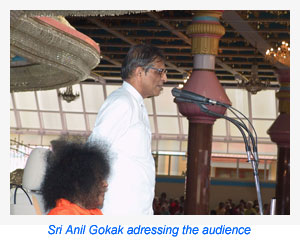


-.jpg)
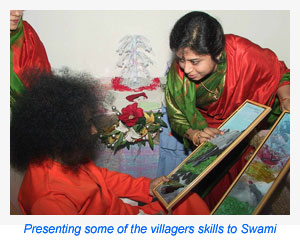



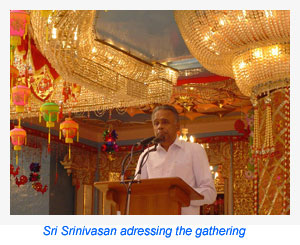
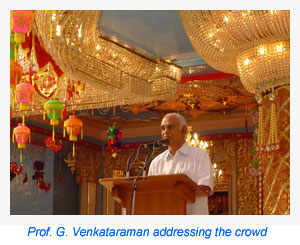
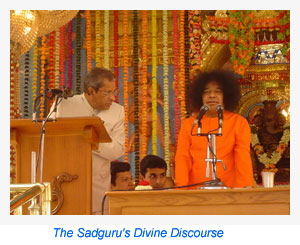 Bhagavan started His divine discourse talking about the consequences of one's actions. He said," People may act as they please, but they cannot escape from the consequences of their actions. Whether he is a pamara (simpleton) or a mahaneeya (noble soul), he has to face the results of his actions. Wherever you go, the results of your actions will follow you like your shadow. However, it is possible to escape from the consequences of action by the grace of God. God is always by your side saying “Tathastu!”, “Tathastu!” (so shall it be!). Man is not taking cognisance of this truth and is indulging in wicked deeds."
Bhagavan started His divine discourse talking about the consequences of one's actions. He said," People may act as they please, but they cannot escape from the consequences of their actions. Whether he is a pamara (simpleton) or a mahaneeya (noble soul), he has to face the results of his actions. Wherever you go, the results of your actions will follow you like your shadow. However, it is possible to escape from the consequences of action by the grace of God. God is always by your side saying “Tathastu!”, “Tathastu!” (so shall it be!). Man is not taking cognisance of this truth and is indulging in wicked deeds."
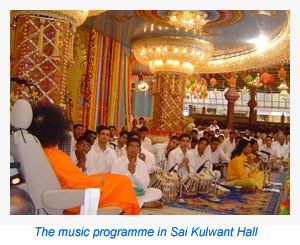
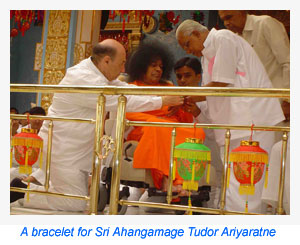
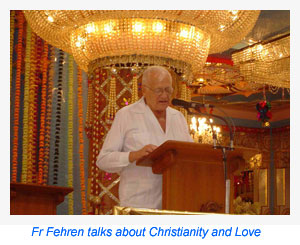

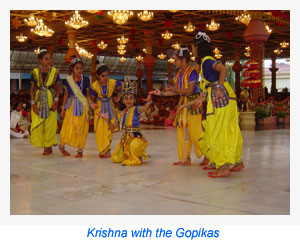
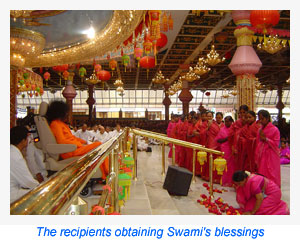
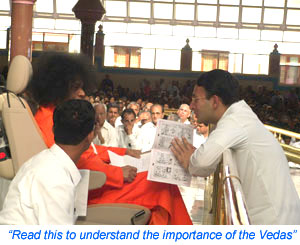
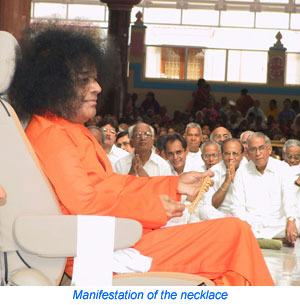 The last stanza of the mantram calls this Narayana Upanishad as the crest jewel of the essence of the four Vedas. If this Upanishad is chanted in the morning, it destroys the sin committed the previous night. If it is chanted in the evening, it removes the sin committed in the day. If it is chanted at noon , it pulverises the five great sins. One who chants this Upanishad will attain the merit of the study of the Vedas and ultimately attains oneness with Narayana.
The last stanza of the mantram calls this Narayana Upanishad as the crest jewel of the essence of the four Vedas. If this Upanishad is chanted in the morning, it destroys the sin committed the previous night. If it is chanted in the evening, it removes the sin committed in the day. If it is chanted at noon , it pulverises the five great sins. One who chants this Upanishad will attain the merit of the study of the Vedas and ultimately attains oneness with Narayana.